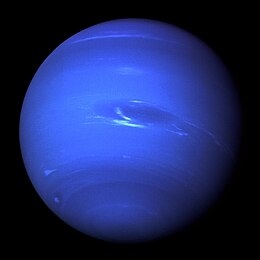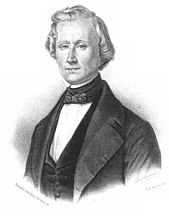Postindustrial Culture refers to the fragmentation of society that has resulted from economic social and technological changes. Economically, our society has moved from an emphasis on manufacturing to more specialized service industries. Whereas in the past, all of your neighbors worked for the same company and did the same kind of work. Today, everyone on your block performs a different job at a different company and for different pay. People today work in careers that did not exist until recently.
 | ||||||
Neptune
Neptune is the eighth and farthest known planet from the Sun in the Solar System. It is the fourth-largest planet by diameter and the third-largest by mass. Among the giant planets in the Solar System, Neptune is the most dense. Neptune is 17 times the mass of Earth and is slightly more massive than its near-twin Uranus, which is 15 times the mass of Earth and slightly larger than Neptune.Neptune orbits the Sun once every 164.8 years at an average distance of 30.1 astronomical units (4.50×109 km). Named after the Roman god of the sea, its astronomical symbol is ♆, a version of the god Neptune's trident.
Neptune is not visible to the unaided eye and is the only planet in the Solar System found by mathematical prediction rather than by empirical observation. Unexpected changes in the orbit of Uranus led Alexis Bouvard to deduce that its orbit was subject to gravitational perturbation by an unknown planet. Neptune was subsequently observed with a telescope on 23 September 1846[1] by Johann Galle within a degree of the position predicted by Urbain Le Verrier. Its largest moon, Triton, was discovered shortly thereafter, though none of the planet's remaining known 14 moons were located telescopically until the 20th century. The planet's distance from Earth gives it a very small apparent size, making it challenging to study with Earth-based telescopes. Neptune was visited by Voyager 2, when it flew by the planet on 25 August 1989. The advent of the Hubble Space Telescope and large ground-based telescopes with adaptive optics has recently allowed for additional detailed observations from afar.
Neptune is similar in composition to Uranus, and both have compositions that differ from those of the larger gas giants, Jupiter and Saturn. Like Jupiter and Saturn, Neptune's atmosphere is composed primarily of hydrogen and helium, along with traces of hydrocarbons and possiblynitrogen, but contains a higher proportion of "ices" such as water, ammonia, and methane. However, its interior, like that of Uranus, is primarily composed of ices and rock, and hence Uranus and Neptune are normally considered "ice giants" to emphasise this distinction.Traces of methane in the outermost regions in part account for the planet's blue appearance.
In contrast to the hazy, relatively featureless atmosphere of Uranus, Neptune's atmosphere has active and visible weather patterns. For example, at the time of the Voyager 2 flyby in 1989, the planet's southern hemisphere had a Great Dark Spot comparable to the Great Red Spot on Jupiter. These weather patterns are driven by the strongest sustained winds of any planet in the Solar System, with recorded wind speeds as high as 2,100 kilometres per hour - Because of its great distance from the Sun, Neptune's outer atmosphere is one of the coldest places in the Solar System, with temperatures at its cloud tops approaching 55 K(−218 °C). Temperatures at the planet's center are approximately 5,400 K (5,100 °C). Neptune has a faint and fragmented ring system (labelled "arcs"), which was first detected during the 1960s and confirmed by Voyager I Digress: Back To The Analysis Society is stratified along different lines than it was in the past. People have formed new social relationships. You might know your coworkers, for instance, better than you do your next door neighbor. Although electronic media did not cause the widespread fragmentation of society, they have done a great deal to enable audience diversity. We no longer think of ourselves as living in a unified world. Whenever advertises can target their products to individuals, as opposed to groups , they foster the idea that each person is an autonomous consumer. Technology has allowed us to replace the face-to-face interaction that characterized past communities with mediated interactions. When I read The New York Times and my neighbor reads Los Angeles Times and we both live in Missouri, our concept of community is at least partially altered. Persuaders then are faced with the demand of targeting unique messages to specific individuals. In addition, audience members struggle to define themselves in a postindustrial world. | ||||||
History
Discovery
Some of the earliest recorded observations ever made through a telescope, Galileo's drawings on 28 December 1612 and 27 January 1613, contain plotted points that match up with what is now known to be the position of Neptune. On both occasions, Galileo seems to have mistaken Neptune for a fixed star when it appeared close—in conjunction—to Jupiter in the night sky. At his first observation in December 1612, Neptune was almost stationary in the sky because it had just turned retrograde that day. This apparent backward motion is created when Earth's orbit takes it past an outer planet. Because Neptune was only beginning its yearly retrograde cycle, the motion of the planet was far too slight to be detected with Galileo's small telescope. In July 2009, University of Melbourne physicist David Jamieson announced new evidence suggesting that Galileo was at least aware that the "star" he had observed had moved relative to the fixed stars.
In 1821, Alexis Bouvard published astronomical tables of the orbit of Neptune's neighbor, Uranus. Subsequent observations revealed substantial deviations from the tables, leading Bouvard to hypothesize that an unknown body was perturbing the orbit through gravitational interaction. In 1843, John Couch Adams began work on the orbit of Uranus using the data he had. Via Cambridge Observatory director James Challis, he requested extra data from Sir George Airy, the Astronomer Royal, who supplied it in February 1844. Adams continued to work in 1845–46 and produced several different estimates of a new planet.
In 1845–46, Urbain Le Verrier, independently of Adams, developed his own calculations but aroused no enthusiasm in his compatriots. In June 1846, upon seeing Le Verrier's first published estimate of the planet's longitude and its similarity to Adams's estimate, Airy persuaded Challis to search for the planet. Challis vainly scoured the sky throughout August and September.=
The Postmodern Condition
The electronic media have brought about certain ways of thinking, relating and knowing that dominate contemporary society. Some scholars have called this set of symptoms the postmodern condition. The postmodern condition is marked by a breakdown of common ways of understanding the world. There are many voices today that desire to be heard, and electronic media allow this discussion to occur. Inherent to the postmodern condition is a struggle for power as persuaders attempt to control the meaning of events, images and symbols. Truth, knowledge and certainty are all questioned in a postmodern culture. Postmodernism is often seen as a reaction to our culture's mindset during the Industrial Revolution of the late 19th and early 20th centuries. As new industries, media and ways of knowing emerged people began to question taken-for-granted theories, assumptions and views of reality. Today we are faced with a struggle among various interests to manage power in our culture. Persuasion and media are central features of this struggle today.

With this understanding of how our contemporary world and its inhabitants are influenced by media, lets turn our attention to the specific nature of persuasion within the electronic world. Persuasion in the media age is different from persuasion in years past because of its increased attention to using technology to reach specific audiences because of differences in consciousness that exist among audience members and because of the type of information that is used to persuade audiences.
The End



No comments:
Post a Comment